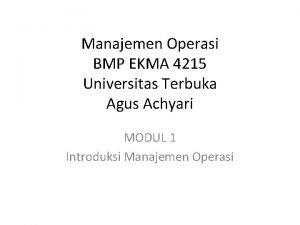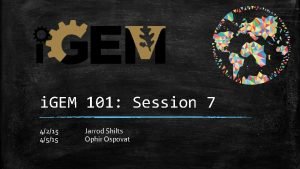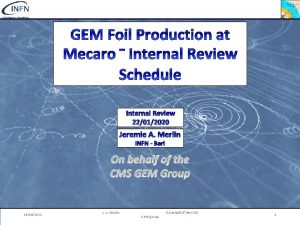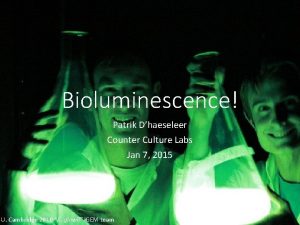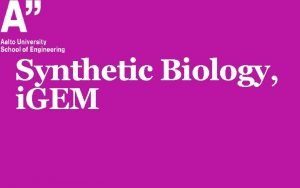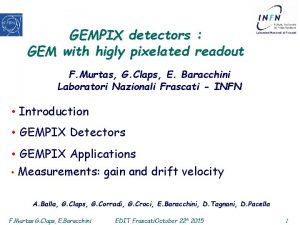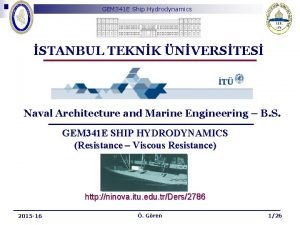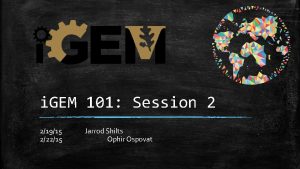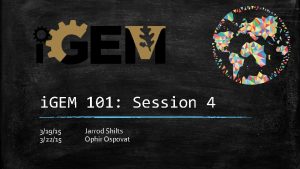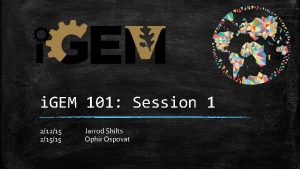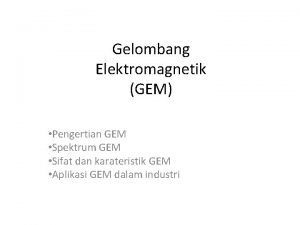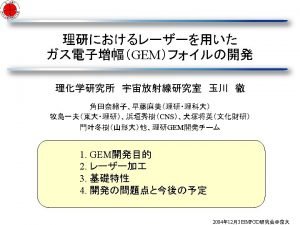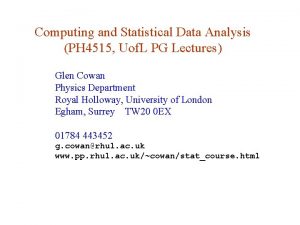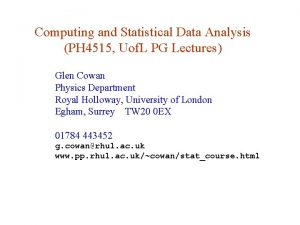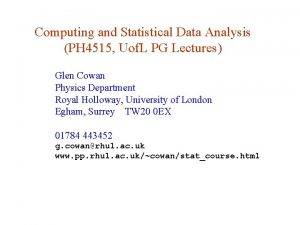i GEM 101 Session 7 4215 4515 Jarrod


















- Slides: 18

i. GEM 101: Session 7 4/2/15 4/5/15 Jarrod Shilts Ophir Ospovat

Purpose of Model Organisms § Simplified system § Tiers of complexity § Evolutionary similarities § Limitations and advantages § Coordinating research § Depth of understanding § Community of investigators § Accumulated resources and knowledge § Databases, pathways, protocols, and tools § Historical contingency

Uses of Model Organisms ▪ Basic Research ▪ Disease Models ▪ Applied Biology

Model Organism Commonalities ▪ Rapid generation time – Short life cycle, many progeny ▪ Easy to maintain ▪ Evolutionary conservation – Pathways of interest – Homologs for disease genes ▪ Available information – Prior research, genome sequence, protocols, et cetera ▪ Unique specialties – Specific research focuses – Useful attributes

Overview ▪ Cell-Free Systems ▪ Prokaryotes – Eschercicia coli – Bactillus subtilus – Other specialized strains ▪ Eukaryotes – – – – Saccharomyces cervisae Cell lines Caenorhabditis elegans Drosophila melanogaster Musculus Arabidopsis thalina Other specialized organisms

Cell-Free Systems ▪ Abiotic conditions – Cell enzymes – Cytosolic cofactors and energy sources – No preexisting genetic material ▪ Control over contents – Purify enzymes, nucleic acids, and even available nutrients and precursors ▪ Ongoing refinement – In vitro transcription and translation – Biochemical reactions – Minicells

Eschericia coli ▪ Most common bacterial model – – Gram-negative bacterium Small genome (1 chromosome, 3000 genes) Doubling time less than 1 hour Safe (biosafety level 1) ▪ Many strains available for lab applications – High efficiency peptide secretion – Increased rate DNA transformation – Other specializations ▪ Extensive Synbio use – Most biobrick parts for E. coli


Bacillus subtilis ▪ Second most common bacterial model – – Gram-positive bacterium Only 200 essential genes (4 k total) Spore forming Safe (biosafety level 1) ▪ Natural competence – DNA transformation without chemical treatment ▪ High enzyme secretion – 60% of prokaryote-produced enzymes

Other Prokaryotes ▪ Methanococcus – Methanogenic archae ▪ Mesoplasma florum – Very small genome (800, 000 bases) – Modified stop codon ▪ Azotobacter – Aerobic extracellularly, anaerobic intracellularly (specialized applications) ▪ Mycoplasma – Artificial genomes – Minimal cells

Saccharomyces cerevisiae ▪ Budding Yeast – – Single celled eukaryote Relatively little non-coding DNA Doubling period of 2 hours Visible cell cycle ▪ Genetic manipulations – Capable of transformation – High rates of recombination – Integrates plasmid genes ▪ Other fungi – Schizosaccharomyces pombe – Neurospora crassa

Mammalian Cells ▪ Immortalized cell lines – Many strains available from multiple cell types – Human cells or from other mammals – Fibroblasts common – Eukaryotic, singled celled ▪ Cell culture – Growth factors – Possibly ECM ▪ Introduce DNA by virus

Caenorhabditis elegans ▪ Nematode worms – Multicellular eukaryote (Eutely with just over 1000 cells) – Hermaphroditic with hundreds of progeny per worm – Simple tissues ▪ Simple nervous system – Complete connectome – Development tracked ▪ Genetic manipulations – Similar in span to Drosophila

Drosophila melanogaster ▪ Fruit flies – Complex animal with complete organ systems – Small genome (three chromosomes) – Life span just over one week ▪ Characterized biology – Developmental stages – Nervous and other systems ▪ Genetic manipulations – Targeted gene modifications – Genetics-based tools for studying proteins at high resolution (ex. GRASP, MARCM)

Mus Musculus ▪ House mouse – Advanced mammalian model – High similarity to humans – Generation time of couple months ▪ Human disease models ▪ Genetic manipulations – Approaching the level available for invertebrate models – Crossing steps like Drosophila, but significantly longer ▪ Also Rattus norvegicus

Arabidopsis thaliana ▪ Thale cress – Predominant plant model – Rapid growth in one month – Studied plant physiology ▪ DNA transformation by Agrobacterium

Other Eukaryote models ▪ Chlamydomonas reinhardtii – Unicellular algae ▪ Zea mays – Maize for agricultural research ▪ Xenopus laevis – Frog for embryological studies ▪ Danio rerio – Zebrafish for developmental studies ▪ Macaca mulatta – Rhessus monkey for disease and cognition studies



